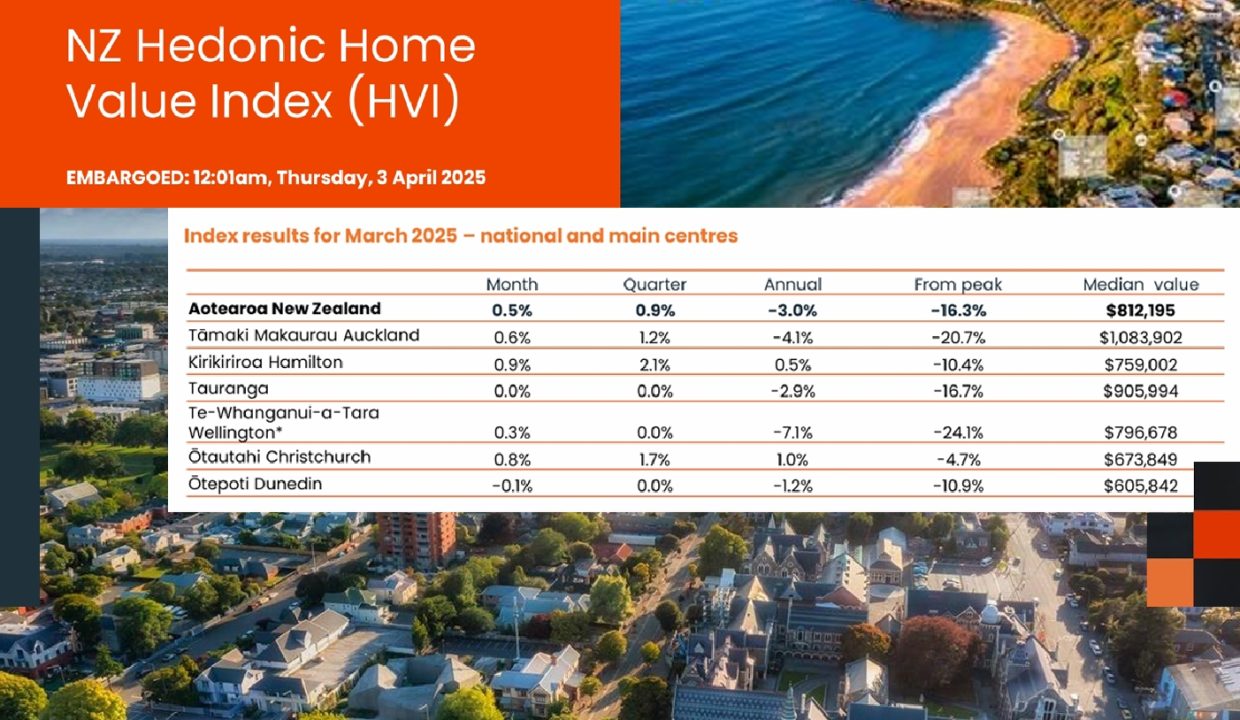
뉴질랜드 부동산 시장, 금리 인하에 따른 완만한 상승세 시작
The next upturn is slowly building

Property values in Aotearoa New Zealand rose by +0.5% in March, after a +0.4% lift in February, and a flat result for January. The latest figures confirm that the market is now into its next phase of growth, on the back of lower interest rates and improved affordability after the previous value falls.
March’s rise on the CoreLogic hedonic Home Value Index (HVI) was the strongest since January last year. Property values are now sitting at $812,195, the highest since June 2024 ($818,649). However, values are still down by 16.3% compared to the previous January 2022 peak.
Around the main centres, Ōtepoti Dunedin (-0.1%) and Tauranga (0.0%) were still a bit more subdued in March, but Te Whanganui-a-Tara Wellington saw a +0.3% rise, with Tāmaki Makaurau Auckland up by +0.6%, Ōtautahi Christchurch +0.8%, and Kirikiriroa Hamilton at +0.9%.
CoreLogic NZ Chief Property Economist Kelvin Davidson said that March’s result simply builds on the previous month’s rise, signalling the next phase in NZ’s property market has begun.
“The falls in mortgage rates since around July or August last year were always going to take a little bit of time to flow through to house prices, given the weak economic environment and subdued household confidence,” he said.
“The abundance of listings has been an extra limiting factor for property values, while some households on higher fixed interest rates from a year or two ago have also had to be patient before seeing their debt repayments drop.”
“But the lags have now worked their way through the system and, with signs becoming clearer that the economy has started to turn a corner, confidence is returning to the property market.”
“That said, a fresh boom in house prices seems unlikely, given additional restraints that are now in place, such as caps on debt-to-income ratios for mortgage lending.”
“Undoubtedly, this cautious outlook will be welcomed by aspiring buyers who may have been concerned about property values rising beyond their reach again, provided that they can navigate the new credit rules in the first place.”
Index results for March 2025 – national and main centres

Tāmaki Makaurau Auckland
March was a stronger month across the board in Tāmaki Makaurau, with Rodney seeing a +0.3% rise in values, Franklin at +0.5%, and then right up to +0.8% in Papakura, and +0.9% in North Shore.
Clearer signs of growth are also evident across a broader three-month horizon, with Auckland City, Papakura, and Franklin all up by 1.6% or more so far in 2025.
Mr Davidson said, “Clearly, Auckland is still a challenging market for some would-be buyers, with affordability pressures lingering. But we’ve been detecting a change in sentiment on the ground across Auckland for a few months now, and this is flowing through to the hard data.”

Te Whanganui-a-Tara Wellington
The wider Te Whanganui-a-Tara Wellington area also strengthened in March, albeit there was a relatively minor -0.2% drop in values in Upper Hutt.
Elsewhere, Lower Hutt and Wellington City rose by +0.3% apiece, with Porirua up by +0.6%, and Kapiti Coast recording a robust increase of +1.4%.
Some areas are still slightly lower than they were three months ago, but Lower Hutt (+0.6%) and Kapiti Coast (+2.4%) have increased over the year to date.
“Wellington’s property market has underperformed over the past few years, with the previous boom meaning that some excesses needed to be worked off, and the public sector cutbacks then weighing on values too. But conditions are now turning around in the property market, with some buyers probably finding ‘value’ again.”

Regional results
March was also a tale of emerging upturn across nearly all of the key provincial markets, with only Nelson recording a modest -0.1% fall in values. New Plymouth and Invercargill were flat, while Napier, Palmerston North, and Queenstown only saw mild increases of +0.1%.
But Whangarei and Rotorua were up by +0.5%, and Whanganui topped the charts for these areas with an increase of +0.8% in March. Each of the key regional areas is also higher than December last year, except for Nelson (-0.6%).
“In the current environment where listings are higher than normal in many parts of the country and some sectors of the economy are yet to rebound, a bit of variability across the provinces is to be expected. But lower interest rates are a significant support, so the outlook for a modest recovery in values this year is likely to be replicated across regional markets too,” added Mr Davidson.

Property market outlook
Looking ahead, Mr Davidson noted that property values may remain a bit patchy or variable from month to month and across regions in the short to medium term, given the economy is not back to full growth mode. Also, buyers generally continue to hold the upper hand when it comes to negotiating on price, benefitting from the elevated number of listings that persists across the market.
”That said, even though most aspiring buyers can still be quite picky about the properties they look at, we’re also now seeing the impact that lower interest rates can have in the property market again.”
“Indeed, there’s now a broad consensus among analysts that national values will rise this calendar year by around 5% or perhaps a little more, with cheaper debt pushing housing prices upwards, but restraints such as the DTIs working in the opposite direction.”
“In the context of past upturns and given that we’re still down around 16% from the post-COVID peak, the expected growth in values this year is fairly modest.”
“No doubt, some people might be disappointed by that outlook. But as a country we don’t get materially wealthier by trading houses amongst ourselves, and a period of flatter values will be happily accepted by many others,” he concluded.
For more property news and insights, visit www.corelogic.co.nz/news-research.

뉴질랜드 부동산 시장, 금리 인하에 따른 완만한 상승세 시작
뉴질랜드의 부동산 가치가 3월에 0.5% 상승했다. 이는 2월의 0.4% 상승에 이어 1월의 보합세 이후 꾸준한 회복세를 보이고 있음을 의미한다. 금리 인하와 이전 가치 하락에 따른 주택 구매 여력 회복이 부동산 시장의 새로운 성장 국면을 견인하고 있다.
코어로직(CoreLogic)의 헤도닉 주택 가치 지수(HVI)에 따르면 3월의 상승 폭은 지난해 1월 이후 가장 높은 수준이다. 현재 평균 주택 가치는 81만 2,195달러로, 2024년 6월의 81만 8,649달러 이후 최고치를 기록했다. 다만, 2022년 1월의 최고점과 비교하면 여전히 16.3% 낮은 수준이다.
주요 도시별로는 오타고의 더니든(-0.1%)과 타우랑가(0.0%)가 다소 주춤했으나, 웰링턴(0.3%), 오클랜드(0.6%), 크라이스트처치(0.8%), 해밀턴(0.9%) 등에서는 상승세가 뚜렷했다.
코어로직 뉴질랜드의 수석 부동산 경제학자 켈빈 데이비슨은 “이번 상승세는 지난달의 흐름을 이어가며 뉴질랜드 부동산 시장의 새로운 국면이 시작됐음을 시사한다”고 분석했다.
그는 “작년 7~8월 이후 주택담보대출 금리가 하락했음에도 불구하고, 경제 불확실성과 가계 신뢰 저하로 인해 부동산 가격 상승이 지연됐다”며 “다만, 대출 규제와 높은 금리에 직면한 가계가 점차 시장 환경에 적응하면서 변화가 나타나고 있다”고 설명했다.
또한, “경제 회복 조짐이 보이면서 부동산 시장에서도 신뢰가 회복되고 있지만, 주택 가격이 급등하는 새로운 붐이 일어나기는 어려울 것”이라며 “특히, 대출 대비 소득(DTI) 비율 제한과 같은 추가 규제가 부동산 가격 급등을 억제하는 요소로 작용할 것”이라고 덧붙였다.
그는 “가격이 천정부지로 치솟을 것이라는 우려가 사라지면서, 신규 구매자들에게는 보다 안정적인 환경이 조성될 것으로 보인다”고 말했다.
Index results for March 2025 – national and main centres

오클랜드(Tāmaki Makaurau), 상승세 뚜렷
3월 한 달 동안 오클랜드 전역에서 부동산 가치 상승이 두드러졌다. 로드니 지역은 0.3%, 프랭클린은 0.5%, 파파쿠라는 0.8%, 노스쇼어는 0.9% 상승했다.
더 넓은 3개월 기간을 기준으로 보면 오클랜드 시내, 파파쿠라, 프랭클린 지역에서 각각 1.6% 이상의 상승률을 기록하며 회복세를 보이고 있다.
데이비슨은 “오클랜드는 여전히 일부 구매자들에게 부담스러운 시장이지만, 최근 몇 개월간 시장 분위기가 변하고 있으며, 이러한 변화가 데이터에도 반영되고 있다”고 평가했다.

웰링턴(Te Whanganui-a-Tara), 점진적 회복세
웰링턴 광역 지역도 3월에 강세를 보였지만, 어퍼 헛(Upper Hutt)에서는 0.2%의 소폭 하락이 있었다.
반면, 로어 헛(Lower Hutt)과 웰링턴 시내는 각각 0.3% 상승했으며, 포리루아(Porirua)는 0.6%, 카피티 코스트(Kāpiti Coast)는 1.4% 상승했다. 일부 지역에서는 여전히 3개월 전보다 낮은 수준이지만, 로어 헛(0.6%)과 카피티 코스트(2.4%)는 올해 들어 꾸준한 상승세를 보이고 있다.
데이비슨은 “웰링턴 부동산 시장은 지난 몇 년간 부진했지만, 최근 다시 활력을 찾고 있다”며 “과거 급등했던 주택 가격이 조정 국면을 거친 후, 현재는 일부 구매자들이 다시 투자 가치를 찾는 단계”라고 분석했다.

지역별 동향
3월에는 주요 지방 시장에서도 점진적인 회복세가 나타났다. 넬슨(Nelson)만이 0.1% 하락을 기록했으며, 뉴플리머스(New Plymouth)와 인버카길(Invercargill)은 보합세를 보였다. 네이피어(Napier), 팔머스턴 노스(Palmerston North), 퀸스타운(Queenstown) 등은 0.1%씩 소폭 상승했다.
그러나, 왕가레이(Whangarei)와 로토루아(Rotorua)는 각각 0.5% 상승했으며, 왕가누이(Whanganui)는 0.8% 상승하며 지방 시장 중 가장 높은 상승률을 기록했다. 넬슨(-0.6%)을 제외한 주요 지방 시장은 모두 지난해 12월보다 높은 수준을 유지하고 있다.
데이비슨은 “현재 많은 지역에서 매물이 풍부한 상황이고, 일부 경제 부문은 아직 완전히 회복되지 않았기 때문에 지방 시장에서 지역별 변동성이 나타나는 것은 당연한 현상”이라면서도 “낮은 금리가 부동산 시장에 긍정적인 영향을 미치고 있어, 올해 전반적인 주택 가치 회복이 지방 시장에서도 지속될 가능성이 높다”고 전망했다.

부동산 시장 전망
데이비슨은 “경제가 완전한 성장 모드로 전환되지 않은 상황에서, 단기적으로는 지역별·월별로 부동산 가격의 변동성이 유지될 것”이라고 전망했다. 그는 “여전히 시장에서 매물이 많기 때문에, 구매자들이 가격 협상에서 우위를 점하고 있다”고 덧붙였다.
그는 “그럼에도 불구하고, 금리 인하가 다시 부동산 시장에 영향을 미치고 있으며, 대부분의 분석가들은 올해 뉴질랜드 전국 평균 부동산 가치가 약 5% 또는 그 이상 상승할 것으로 예상하고 있다”고 말했다. 다만, “저금리가 주택 가격을 밀어올리는 반면, 대출 규제(DTI) 등이 상승폭을 제한할 것”이라고 분석했다.
그는 “과거 상승장과 비교하면 올해 예상되는 상승폭은 비교적 완만한 수준이며, 여전히 코로나19 이후의 최고점 대비 약 16% 낮은 상태”라고 강조했다.
마지막으로 그는 “일부 사람들은 이러한 전망에 실망할 수도 있지만, 국가 경제가 단순한 부동산 거래로 인해 실질적으로 부유해지는 것은 아니다”라며 “부동산 가치가 비교적 안정적인 흐름을 보이는 것을 반기는 이들도 많을 것”이라고 덧붙였다.
